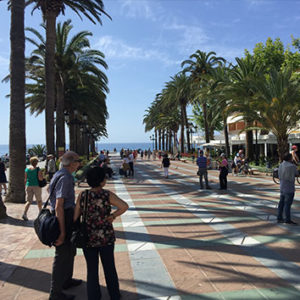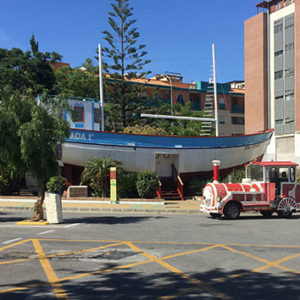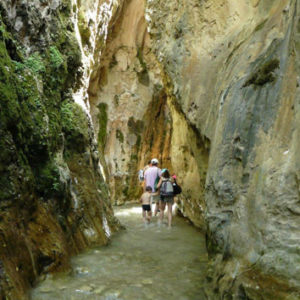If you are looking for things to do in Nerja then you are at the right place. Please read what I recommend that you see in Nerja.
Firstly you should know that Nerja is a fishing village with a population of around twenty thousand people, one-third of which are foreigners (mostly British).
In Nerja it’s summer almost all year round, so there are many open-air activities on offer.
It borders with Frigiliana, Torrox and La Herradura, which are also beautiful towns with lots to offer.
Summer and winter options
While you are in Nerja, you must visit the Nerja caves.
Amazing caves discovered in 1959 where you will find the old work of art known to man, a rock painting which is roughly forty-two thousand years old. You can also find the largest stalactite in the world.
The caves are open every day of the week, every day of the year, except for January 1st because of New Year and the 15th of May because of the San Isidro festival. Prices are under 10€ per adult and under 5€ for children under the age of 12 and completely free for children under the age of 6.
Remember, it will be one of the best things your kids can see in Nerja!
There’s a number of ways to get to the Nerja caves (they are in the Maro district):
- By bus. You can get a bus which is heading towards Granada and the first stop will be Maro. Get off and walk for a couple of minutes. The bus departs from the local bus station on Pescia avenue.
- By Nerja taxis. You can get a taxi from either La Ermita square, the local bus stop or the taxi rank on Castilla Perez street. Learn more about the taxi ranks.
- By coche. You can take your own car, the caves are easy to find because they are well pointed out. All you need to do is drive east of Nerja on the N-340 towards Granada and stop off at Maro. The caves have their own car park.
- The train. There is a small “train” that goes around town and heads towards to cave. The “train” is red and you can get on it from a number of stops. I recommend getting on at Plaza España, where you can also find the cave’s own museum.
The caves are a must see, click here to find out more about them.
You should visit the museum is you want to learn about all the intricacies the caves have to offer. You can enjoy a stroll through the various rooms and see replicas of archeological discoveries made in the Nerja caves
It’s situated in Plaza España, next to the Balcón de Europa and is open to everyone. Prices are 4€ for adults and 2€ for children between 6 and 12 years. Kids under 6 get in for free.
Another must-see in Nerja are the beaches. There’s 10 beaches in the town center and another 6 on the outskirts. The beaches on the outskirts can be found on the road from Nerja to Maro.
Where to visit in the area
Frigiliana is a beautiful white-washed village in the mountains only seven kilometers from Nerja. Here you will see how tourism and agricultural life mix in a unique way. The pebble streets are windy just like a Moorish town. Walking through this town you’ll find great restaurants with homemade food that will surprise even the most experienced mouths. We recommend trying the sugar cane honey (the factory is also worth a visit) and also trying the tapas around town.
If you wish to prepare a more specific route in Frigiliana or just learn more about the town then head to the tourist office situated on Cuesta del Apero. You can also give them a call on 95 253 42 61 (0034 is the Spanish code) or just drop them an email at oficinadeturismo@frigiliana.es0
Maro is a small district in Nerja with a roman origin. It’s mostly an agricultural town but tourism is on the rise thanks to the cliffs and beache on display. Also to see here is the Acueducto del Águila (The eagle’s aqueduct) and the Nerja Caves.
Acueducto del Águila
Acueducto construido en el siglo XIX por Francisco cantero, que se usaba para transportar agua a la Antigua Fabrica de Azúcar de San Joaquín de Maro. Su visita es gratuita, y libre de hacer a cualquier horario. Para encontrar el acueducto deberás dirigirte desde Nerja, en coche o a pie hasta un kilómetro aproximadamente antes de llegar a Maro por la N-340. No te preocupes que si continuas por la carretera lo verás sin problema.
Acantilados de Maro
The Acueducto del Águila was built in the XIX century and was used to transport water to the old sugar factory (Antigua Fábrica de Azúcar de San Joaquin de Maro). There’s no entry fee and you can access this attraction at any time of the day. To aqueduct can be found on the road between Nerja and Maro, keep your eyes open and you will see it no problem at all.
The Maro cliffs are amazing to look at. They have formed beaches which you can get to by car. We recommend making regular stops so you can take in all the scenery. Head to the balcony of Maro and then drive along the cliffs. If you continue driving, you will reach Cerro Gordo where the best views can be found. The plants, the sea, the wind, the smells all make this place worth the drive.
Almuñecar is a small town east of Nerja. On the way there you can find the Marina del Este port, a small sport with lots of charm and great restaurants. In Almuñecar there is an aquarium and a water park (Aquatropic). I recommend this water park because it is cheaper than others, that said, they use salt water instead of fresh water.
In the capital, you can do a million things. You could visit the port and walk along the promenade where you will find shops and restaurants.You could visit the cathedral or the roman theater. You could go to Gibralfaro and get one of the best views in Málaga. You could go to Larios street for a stroll and maybe a bite to eat. Or you could just go to one of the many museums on offer: Picasso museum, Thyseen museum, Pompidou museum, etc.









